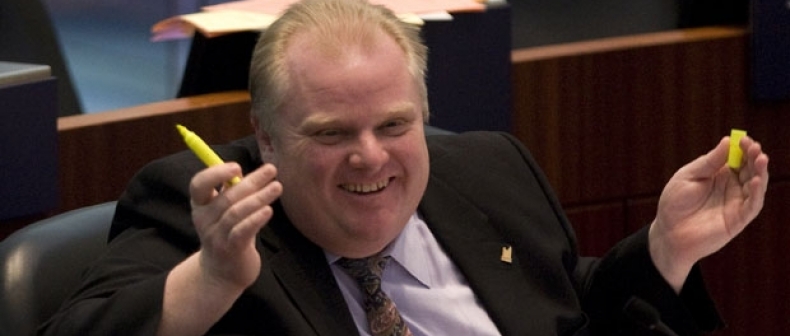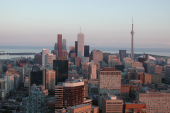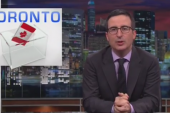
I get jittery when everyone is on the same side of an issue. Like Rob Ford’s subway. So let me take a stab at a contrary view.
What if Ford’s right?
He wouldn’t be right for especially good reasons — though he has exhibited many fine qualities over the years, he still seems deeply unintelligent, and the Sheppard line is an odd one to be nailing your colours to — but it wouldn’t be the first time someone was on the right side of an issue for the wrong reasons.
What’s giving me these unsettling little glimmers of doubt are a couple of books I read in the last couple of years. Unbuilt Toronto and Unbuilt Toronto II by Mark Osbaldeston are about what hasn’t happened in this city, and in them — among the tales of genius architects snubbed and neighbourhoods not razed to make room for highways — are story after story, from the beginning of municipal history until extremely recently, of the ambitious being trumped by the practical, decisions made out of consideration of what is “appropriate and practical.” Sometimes it’s the politicians, sometimes it’s the citizenry, but the reasoning is always the same.
Take Vimy Circle, for instance. It was meant to honour our war dead and would have made up a part of a ceremonial Federal Avenue running directly from City Hall to Union Station. A grand avenue of the sort that gives a city a sense of pride in itself, in its contributions to the world, the sport that eventually connects a place to its history.
People liked the idea, but in the end, the city figured it wasn’t necessary that there were more efficient, less costly ways of achieving the same basic ends.
We’ve even visited this subway question before, twice, once when we almost built a subway system a full four decades before we actually did, and again, when it was called Network 2011 in the 1980s, that would have built lines along Eglinton and Queen.
So when I hear the eminently reasonable arguments from Ford’s various opponents, and from this transit panel, about how much less expensive the LRT would be, how much easier to build, how it’s the right thing for right now, it rankles. I’ve heard this before. It’s Vimy all over again.
Cities are not businesses. They do not need to show a profit, or even break even, They are, unlike businesses, meant to be around for centuries, and are meant to serve their population. This is often expensive, with today’s governments needing to make commitments on future generations’ behalf.
Ford’s stupidity comes in how he sees paying for all the subway he wants. As we’ve seen in Denver and Los Angeles, people are often happy to pay for good transit, for transit they can get excited about. There’s nothing more inherently evil about taxes than there is about ticket prices at the ACC. We may quibble with the amount, but we don’t try to argue that we shouldn’t be paying at all. But the Fords are nothing if not ignorant populists, second-guessing their constituency, and convincing a good number of them, just as they convince themselves, that peppy-sounding rhetoric is actually reasoning.
Torontonians are practical to a fault. We have been for centuries, and our waterfront, our public buildings, our cultural centres and our main streets are testament to the fact. They all work, and in fact we do wonderful things with them, but we suffer from a real deficit of grand. Our opera house, a brick schoolhouse with a picture window, is only the most recent sin of omission. I took a trip to Winnipeg a few months ago. I’d always thought of High Park as a place I really should spend more time in, but after visiting Winnipeg’s much more effortful version, Assiniboine Park, I realized the reason I didn’t spend more time there is that it’s kind of a crap park. They’ve put very little effort into the landscaping, amenities, anything that might make it attractive enough to cross town for.
But we’re getting better. The last 10 years, though still not that architecturally impressive, have seen enormous improvements to the urban fabric of Toronto. And if the renderings on the hoardings around town are any indication, even the architecture’s going to be getting better, or at least more interesting, in the next decade. Could it be time to raid the piggy bank, not to steal from our children, grandchildren and great-grandchildren, but to invest in the city they’ll be taking over. That city’s not going to be any smaller than this one.
Are you familiar with the idea of desire lines? They’re those worn-down paths in parks, the ones that branch of from sidewalks and cut across the grass, between the trees, a people’s hypotenuse. In Finland, I hear, when the city wants to pave some new paths, they send workers out right after a fresh snow, to see where people are walking. Desire lines are any paths, roads or other routes, officially acknowledged or not, that people exhibit a preference for.
There’s a lovely map, created by cartographer Eric Fischer, that tracks Toronto’s desire lines based on their geotagged tweets. True, not everyone tweets, and not everyone who tweets geotags their tweets. But those who do have not been shown to have drastically different traveling patterns than those who don’t. The great thing about Fischer’s maps — he’s done the same thing for several cities — is that they make those desire lines look very much like veins and arteries. It lends itself nicely to the metaphor of the city as a body that needs circulation to survive and thrive, and as a city grows, it needs to encourage that blood supply.
At the moment, without a unifying transit system, if I’m not on my bike, I’m very unlikely to decide to zip over from the Annex to Roncesvalles if I know I have to transfer to a bus at Dundas West station, or take the subway to Osgoode and transfer to a streetcar that could take anywhere from 1 to 15 minutes to arrive. There are parts of the city, like the Bayview strip, for instance, that I almost never go to for this very reason. There are other sections, like Windfields, say, or Bendale, that are off the radar for everyone who didn’t live or work there, and the Peanut Plaza, a wonder of an independent neighbourhood mall, is, I’m sure, still a mystery to most. If I could walk down into one subway station, and come out at another, transfers or not, I’d be going to the Peanut Plaza and bringing home some Allan’s hardo bread way more often. I’m sure others would, too.
It can be difficult to put your finger on what’s not there; it’s much easier to criticize or praise something that is. But books like Osbaldeston’s do let us see the patterns. You never go too wrong with appropriate and practical, but you never go too right, either.
________
Bert Archer writes about media and real estate for Toronto Standard. Follow him on Twitter: @bertarcher.
For more, follow us on Twitter: @TorontoStandard, or subscribe to our newsletter.














